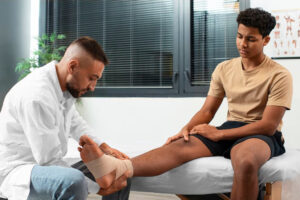Foot and ankle injuries are among the most common sports-related injuries, affecting athletes of all ages and skill levels. These injuries can range from mild sprains and strains to severe fractures and tendon ruptures. Prompt diagnosis and appropriate management are crucial for a safe and effective return to activity.
Common Types of Foot and Ankle Sports Injuries
- Sprains and Strains: Ligament sprains (especially of the ankle) and muscle or tendon strains are frequent, often caused by twisting, rolling, or overextending the joint.
- Fractures: Breaks in the bones of the foot or ankle can result from direct trauma, falls, or severe twisting injuries.
- Tendinitis and Tendon Tears: Overuse or acute trauma can lead to inflammation or even rupture of tendons, such as the Achilles tendon.
- Other Injuries: Stress fractures, cartilage injuries, and conditions like plantar fasciitis also commonly affect athletes’ feet and ankles.
Causes and Risk Factors
- Sudden trauma: Twisting, landing awkwardly, or direct impact during sports.
- Overuse: Repetitive strain from running, jumping, or improper technique.
- Inadequate warm-up: Not preparing muscles and joints increases injury risk.
- Improper footwear: Lack of support or worn-out shoes can contribute to instability and injury.
- Previous injuries: A history of foot or ankle injuries raises the risk of recurrence.
Treatment Options
Conservative (Non-Surgical) Treatments
- RICE Protocol: Rest, Ice, Compression, and Elevation are first-line treatments for most mild to moderate injuries.
- Medications: NSAIDs and pain relievers help reduce pain and inflammation.
- Immobilization: Braces, splints, casts, or boots may be used to protect and stabilize the injured area.
- Physical Therapy: Essential for restoring strength, flexibility, and range of motion after immobilization or injury.
- Orthotics: Customized shoe inserts may be recommended for support and to prevent recurrence.
- Steroid Injections: Sometimes used for persistent pain or inflammation.
Surgical Treatments
- Repair of Ligaments/Tendons: For severe tears or ruptures, surgical repair or reconstruction may be needed.
- Fracture Fixation: Severe or displaced fractures may require pins, screws, or plates to stabilize bones.
- Arthroscopy: Minimally invasive surgery to remove debris or repair cartilage and ligament injuries.
- Post-Operative Care: Includes immobilization, gradual weight-bearing, and physical therapy for optimal recovery.
Prevention Tips
- Warm up and stretch before sports to prepare muscles and joints.
- Wear proper, well-fitted footwear to provide support and reduce risk.
- Gradually increase activity levels to avoid overuse injuries.
- Strengthen muscles around the foot and ankle to improve stability.
- Avoid playing when fatigued or already injured to prevent further harm.

When to Seek Medical Attention
Immediate medical evaluation is recommended for:
- Severe pain, swelling, or inability to bear weight
- Visible deformity or suspected fracture
- Persistent instability or recurrent injuries
- Failure to improve with initial home care
Conclusion
Foot and ankle sports injuries are common but manageable with prompt care and proper rehabilitation. Early intervention, individualized treatment, and preventive strategies are key to a safe return to sports and minimizing long-term complications.
FAQs
1. What are the most common foot and ankle injuries in sports?
Sprains, strains, fractures, and tendinitis are the most frequent injuries affecting athletes’ feet and ankles.
2. How are minor foot and ankle injuries treated at home?
The RICE protocol—rest, ice, compression, and elevation—is effective for most mild injuries.
3. When is surgery necessary for a sports-related foot or ankle injury?
Surgery may be needed for severe fractures, complete ligament or tendon tears, or injuries that do not respond to conservative treatment.
4. How long does it take to recover from a foot or ankle sports injury?
Recovery time varies by injury severity; mild sprains may heal in weeks, while fractures or surgical repairs may take months.
5. What can athletes do to prevent foot and ankle injuries?
Warm up properly, wear supportive footwear, strengthen supporting muscles, and avoid playing when fatigued or injured.
Welcome to our clinic, where expert care for foot and ankle sports injuries helps you recover stronger and return to the game. Visit us at https://orthoxpress.co/ or call us at (214) 949-8918 to schedule your appointment today!

